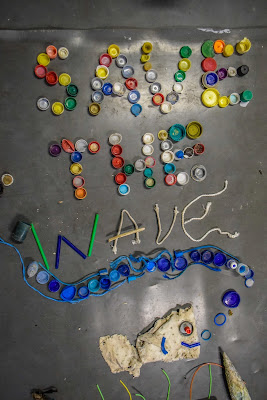Successful completion of
the
“Save the Wave” project
Fish mistaking plastic
debris in ocean for food, study finds. Behavioural evidence suggests marine
organisms are not just ingesting microplastics by accident but actively seeking
them out as food!
Fish may be actively
seeking out plastic debris in the oceans as the tiny pieces appear to smell
similar to their natural prey, new research suggests. The fish confuse plastic
for an edible substance because microplastics in the oceans pick up a covering
of biological material, such as algae, that mimics the smell of food, according
to the study published
in the journal Proceedings of the Royal Society B.
Scientists presented
schools of wild-caught anchovies with plastic debris taken from the oceans, and
with clean pieces of plastic that had never been in the ocean. The anchovies
responded to the odours of the ocean debris in the same way as they do to the
odours of the food they seek.
The scientists said this
was the first behavioural evidence that the chemical signature of plastic
debris was attractive to a marine organism, and reinforces other work
suggesting the odour could be significant.
The finding demonstrates
an additional danger of plastic in the oceans, as it suggests that fish are not
just ingesting the tiny pieces by accident, but actively seeking them out.
Matthew Savoca, of the
National Oceanic and Atmospheric Administration and lead author of the study,
claims: “When plastic floats at sea its surface gets colonised by algae within
days or weeks, a process known as biofouling. Previous research has shown that
this algae produces and emits DMS, an algal based compound that certain marine
animals use to find food. The research shows plastic may be more deceptive to
fish than previously thought. If plastic both looks and smells like food, it is
more difficult for animals like fish to distinguish it as not food.”
Plastic debris in the
oceans, ranging from the microscopic to large visible pieces, is recognised as
a growing problem as it does not readily degrade and hundreds of thousands of
tonnes are dumped in the sea annually. Larger pieces have been found in
the intestines of whales and seabirds, where they are thought to be potentially
fatal, while the smallest pieces have been detected in the guts of even
juvenile fish and molluscs. Numerous species of fish eaten by humans have been found to contain
plastic, and the effect of eating these on
human health is still unknown.
Efforts to reduce marine
plastic have so far had little effect: microbeads widely used in cosmetics and other
products have been banned in the US,
the UK and other countries, but they only solve part of the problem, which
is mainly caused by dumping of plastic rubbish. There could be more plastic than fish in the sea by 2050,
campaigners have warned.
 |
| Fish eat microplastics driven by their odour. Above, debris found in the stomach of a fish in Portugal. Photograph: Paulo Oliveira/Alamy |
Scientists have
struggled to understand exactly how the massive increase in plastics may be
affecting the behaviour of fish and marine ecosystems, and how to contain the
problem.
A previous paper
published in the journal Science that alleged juvenile fish were attracted to
microplastics “like teenagers after junk food” was withdrawn earlier this year after controversy. The scientists involved in that paper, who have no relation to the
authors of today’s study, were suspected of having exaggerated their data or
failed to carry out the purported experiments properly. The new paper did not
draw on that publication.
(Source: the Guardian, August 2017)
The Croatian group of participants
to the “Save the Wave” project meeting, held from 13th to 19th September on
Madeira island in Portugal, witnessed a sea turtle struggling in vain to dive into
the ocean because of the plastic swallowed in its stomach. The sad event
happened during a dolphin watch tour organized as part of the project
activities of the 3 national groups from Croatia, Portugal and Greece under the
frame of the Erasmus+ Youth Exchanges program.
The spectacle became
even more dramatic when the Croatian young people realized that bureaucracy and
lack of directions in emergency cases like that, are a serious obstacle obviously
not only in Madeira, but in many other countries as well.
The objectives of that
second and last meeting of the 3 national groups were to discover how much
effort each participating country makes to fight plastic pollution, and which
policies they develop and implement for the preservation of marine.
The three groups have
also explored and researched, under the coordination of the Croatian organization
“Udruga Prizma” and the support of the partner organizations “Teatro Metaphora”
in Portugal and “Dione” local development centre in Greece, about their
national poets, painters, sculptors, artists, who are deeply connected with
nature and sea.
The conclusion of that
project meeting was that we, like the Fall and the Drop, are all part of the
same chain…





























